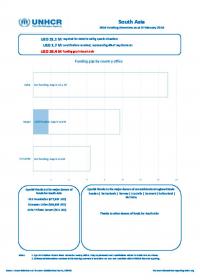Operations

OPERATIONS
Africa
- Central Africa and the Great Lakes
- Burundi
- Cameroon
- Central African Republic
- Congo
- Democratic Republic of the Congo
- Rwanda
- United Republic of Tanzania
- East and Horn of Africa
- Southern Africa
- West Africa
Americas
Asia and the Pacific
Europe
Middle East and North Africa
NEW: 2016 planning information has just been released. Budgets and population planning figures for 2016 and for previous years can be reviewed below. The French version is available in pdf format.
Location
{"longitude":84,"latitude":28,"zoom_level":0}
Latest update of camps and office locations 13 January 2016. By clicking on the icons on the map, additional information is displayed.
Operational Highlights
Operational context and population trends
The overall security situation in Nepal remains stable. While political events since 2012 have not negatively impacted protection, assistance or resettlement activities, refugee issues have yet to gain prominence on the political agenda in Nepal.
UNHCR supported the following four population groups in 2015:
Refugees from Bhutan: Submission for the group resettlement programme for refugees from Bhutan was completed in December 2015, with over 101,200 Bhutanese refugees having departed as of 31st December 2015. As a result of these resettlement departures, the camp population decreased to less than one sixth of its original population of approximately 108,000. Finding durable solutions for the remaining refugees continues to be a challenge. As of 31 December 2015, the two refugee camps in eastern Nepal hosted 17,134 refugees from Bhutan.
Urban asylum-seekers and refugees: UNHCR provided support to 702 urban refugees and asylum-seekers from 11 countries.
Tibetan refugees and new arrivals: UNHCR assisted 89 individuals in Kathmandu.
Individuals affected by the earthquake: In response to the devastating earthquakes that hit Nepal on 25 April and 12 May 2015, UNHCR worked closely with the Government and deployed 11,000 tarpaulins and 4,000 solar lamps from its regular stockpile to distribute across three earthquake-affected districts in central Nepal. Successful private sector fund raising in over 20 countries enabled UNHCR to assist over 200,000 individuals with 42,000 plastic sheets; over 8,000 families with solar lamps; 450 families with shelter roof kits; and over 10,000 children to resume education in the 170 temporary learning centres.
Key priorities in 2016
The objectives set by the Nepal operation are aligned with UNHCR’s global strategic priorities.
Refugees from Bhutan:
The overall security situation in Nepal remains stable. While political events since 2012 have not negatively impacted protection, assistance or resettlement activities, refugee issues have yet to gain prominence on the political agenda in Nepal.
UNHCR supported the following four population groups in 2015:
Refugees from Bhutan: Submission for the group resettlement programme for refugees from Bhutan was completed in December 2015, with over 101,200 Bhutanese refugees having departed as of 31st December 2015. As a result of these resettlement departures, the camp population decreased to less than one sixth of its original population of approximately 108,000. Finding durable solutions for the remaining refugees continues to be a challenge. As of 31 December 2015, the two refugee camps in eastern Nepal hosted 17,134 refugees from Bhutan.
Urban asylum-seekers and refugees: UNHCR provided support to 702 urban refugees and asylum-seekers from 11 countries.
Tibetan refugees and new arrivals: UNHCR assisted 89 individuals in Kathmandu.
Individuals affected by the earthquake: In response to the devastating earthquakes that hit Nepal on 25 April and 12 May 2015, UNHCR worked closely with the Government and deployed 11,000 tarpaulins and 4,000 solar lamps from its regular stockpile to distribute across three earthquake-affected districts in central Nepal. Successful private sector fund raising in over 20 countries enabled UNHCR to assist over 200,000 individuals with 42,000 plastic sheets; over 8,000 families with solar lamps; 450 families with shelter roof kits; and over 10,000 children to resume education in the 170 temporary learning centres.
Key priorities in 2016
The objectives set by the Nepal operation are aligned with UNHCR’s global strategic priorities.
Refugees from Bhutan:
- Continue to advocate for durable solutions for the remaining refugees in Nepal following the conclusion of the group resettlement programme;
- Maintain protection and assistance activities in the camps, in line with international standards;
- Support individual resettlement;
- Implement small-scale host community support projects;
- Enhance protection and community services, such as psycho-social support, child protection services, prevention of SGBV and suicide, women empowerment, support for youth and children with specific needs, and rehabilitation of substance abusers;
- These activities will be implemented for the benefit of both refugees and host communities with a view to strengthen joint support mechanisms with a linkage to district-level referral services.
- Provide assistance to cover basic needs, including a targeted subsistence allowance, primary health care services, and an education allowance for some 100 refugee children;
- Promote durable solutions, including self-reliance and resettlement to third countries for extremely vulnerable individuals or people facing high protection risks.
- Provide basic protection and assistance, including a subsistence allowance for onward movement, accommodation, food, and primary health care services for Tibetans transiting through Nepal;
- Continue to advocate with the Government at all levels for a comprehensive registration exercise for the long-staying Tibetan refugee population.
- Continue to advocate for citizenship documentation in line with international standards and provide relevant technical advice;
- Continue to engage in strategic partnerships with UN agencies, embassies, domestic legal experts and other civil society actors and pursue opportunities for collaboration on a larger scale with the Government in relation to citizenship.
Stories
People of Concern
17%
Decrease in
2014
2014
| 2014 | 39,012 |
| 2013 | 46,966 |
| 2012 | 56,734 |

[["Refugees",38490],["Asylum-seekers",137],["Others of concern",385]]
Loading ...
Budgets and Expenditure for Nepal
< Back
2014
{"categories":[2012,2013,2014,2015,2016],"budget":[15.71760932,15.57919069,15.39627806,17.77909535,9.69132496],"expenditure":[10.68684716,8.69587504,7.64923815,null,null]}
{"categories":[2012,2013,2014,2015,2016],"p1":[12.95508878,9.91735539,10.13508763,9.52812866,9.01183726],"p2":[1.35141954,1.40375575,2.23114183,1.79402556,0.6794877],"p3":[1.411101,4.25807955,3.0300486,2.52347713,null],"p4":[null,null,null,3.933464,null]}
{"categories":[2012,2013,2014,2015,2016],"p1":[9.315841,6.85131978,6.78039167,null,null],"p2":[0.74722816,0.62798725,0.37696446,null,null],"p3":[0.623778,1.21656801,0.49188202,null,null],"p4":[null,null,null,null,null]}
Loading ...



